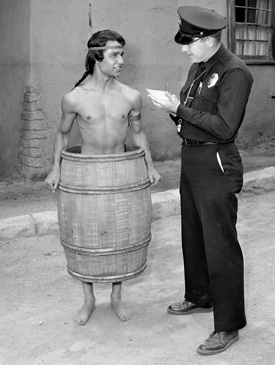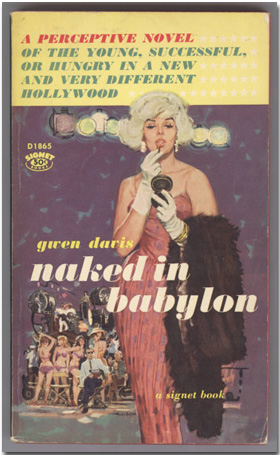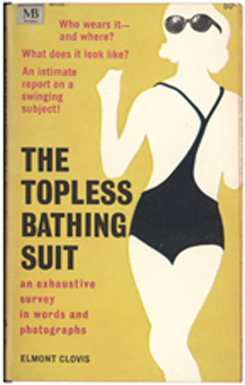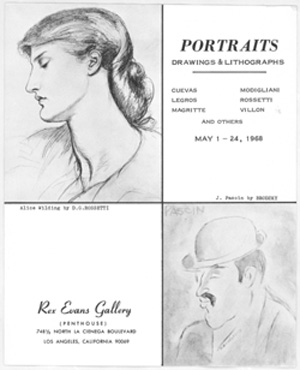
The Department of Special Collections has over 140 collections in the entertainment arts. They document developments in concerts and music, motion pictures, television, and the theater, contributions made by southern Californians to those developments, and the connection of the arts with the growth of the region.

Raymond Chandler, 1888 - 1959. Double Indemnity. [Screenplay by Raymond Chandler and Billy Wilder, from the story by James M. Cain] Hollywood, Sept. 25, 1943. 117 leaves. Typescript (mimeograph). Billy Wilder's copy with notations throughout. In: Chandler, Raymond, 1888 - 1959. Papers, 1930 - 1959. Collection 638 Box 14
Director Billy Wilder has detailed notes on virtually every page of dialogue and all facing blank pages of the mimeographed text. (Barbara Stanwyck is to appear in slacks, white shirt, and black glasses.) Austrian émigré Wilder teamed with Raymond Chandler to delineate specific Los Angeles locales as had never been done before in motion pictures. The characters meet on a street lined with palm trees in a Spanish Colonial bungalow. At Jerry's Market near the writers' employer's studio, the characters meet secretly amid the abundant produce of the market to cover up a murder.
Western Publishing & Novelty Co. Typical Spanish Architecture in Southern California [color postcard]. Los Angeles, 1910s? Codes on verso: A - 89295 and 606. In: Collection of California postcards, 1890 - . Collection 1351. Box 11
By the time of Chandler's and Wilder's screen play, the Spanish Colonial style here depicted had become so ubiquitous that they would describe the décor of their character's bungalow as "Spanish craperoo in style."
 |
Los Angeles Times photo. Sal Mineo publicity shot. 1958. Scanned copy of complete negative with original marks and labels printed approximately 8" x 10". Caption from the Times 1958 May 21: "CAUGHT SHORT - Sal Mineo, who said he'd rather wear a barrel than have a fan accused of stealing, tells Officer Bill Grell how he happened to lose most of his clothes to a giggling group of teen-agers." In: Los Angeles Times. Photographic archives, ca. 1918 - . Collection 1429. Negative 110594 This is but one of millions of negatives in the Times records, and of tens of thousands of photographs relating to Hollywood publicity and history. As is often the case, there is a series of negatives not published. One shows the naked Mineo alone with the concealing barrel, so the idea of being "arrested" seems to have evolved later.
|
|
Gwen Davis. Naked in Babylon. [New York]: New American Library, c1960. In: A collection of books about Hollywood (Los Angeles, Calif.) in literature, ca. 1900 - . Collection 348. Box 5
| 
|
 |
Elmont Clovis. The Topless Bathing Suit: An Exhaustive Survey
in Words and Photographs. Photographs by Paul Duckworth. New York: MacFadden-Bartell
Corp., [1965]. SCB 135691
Los Angeles fashion designer Rudi Gernreich's ideas such as unstructured garments helped create liberated women in the 1960s. His topless bathing suit in 1964 changed the way women dressed in the latter half of the twentieth century. It garnered headlines, as this "sensational" ripoff shows. The cover graphic is a discreet adaptation of a model wearing the topless suit, with copy asking, "Who wears it - and where? What does it look like?" In the early 1970s Gernreich's unisex fashions concepts were the first to blur gender distinctions as a major fashion statement. These changes in the cultural and sexual mores of the times are examples of many which began in Los Angeles. Most of his clothing has been given to other institutions, but the papers at UCLA are the most complete for his family history and the history of his fashion and other businesses. The papers include a small number of documents of gay history, including notes for early meetings of the Mattachine Society in the 1950s. |
Lawrence Morton. "Stravinsky's Le sacré du printemps." 1964. 6 leaves. Typescript (carbon) with minor holograph corrections. Done for the opening concert of the Los Angeles Music Center. Published as "Le sacré du printemps" in: Pavilion. v.1 no.1 [c1964], [16] - 20. In: Morton, Lawrence, 1904 - 1987. Papers, 1908 - 1987. Collection 1522. Box 85
Morton was second director of the Monday Evening Concerts, one of Los Angeles's most distinguished cultural events series, from 1954 - 1971. He wrote articles about chamber music and other music. He wished most to be remembered for his research and writing and collection about Igor Stravinsky. Lawrence Morton was interviewed by the UCLA Oral History Program.
 |
Rex Evans Gallery (Firm: Los Angeles). Portraits Drawings & Lithographs [announcement]. [Los Angeles, 1968]. Works illustrated: Alice Wilding by D. G. Rossetti and J. Pascin by Brodsky. In: Rex Evans Gallery. Records, 1960 - 1973. Collection 1346. Box 1 f.10 The Rex Evans Gallery was operated by Rex Evans and James Weatherford. It opened in Los Angeles on La Cienega Boulevard in 1960 when that area was the center of art dealing. It was the decade of the opening of the Music Center, above, the Los Angeles County Art Museum (now LACMA), and the time of a general expansion of the influence of Los Angeles as a national and international cultural center. |
C. S. Cotelo. White Line Fever. New York: New American Library, 1975. From the screenplay by Ken Friedman and Jonathan Kaplan.
"The hard-driving story of a guy too proud to bend, too tough to break."
Richard Deming. Baby Blue Marine. [New York: New American Library, 1976]. A novel by Max Franklin, from the screenplay by Stanford Whitmore.
"In 1943 every man had to be a hero ... and every girl a virgin."
Dennis Asberg and John Milius. Big Wednesday. New York: Bantam Books, 1978. "They came back for that one final challenge. A stunner of a novel about 3 friends and a day like no other." All three works are in: Collection of moving picture and theatre editions of novels, ca. 1895 - . Box 15
These are 1970s editions associated with motion pictures, yet another collection the Dept. has made of a particular genre of popular literature. These three are movies of actor Jan Michael Vincent, at the height of his popularity during these years. The "red-blooded American male" seemed to have returned. These novelizations are not held by many public institutions. Baby Blue Marine, is, however, listed as held by the library of the Quantico (Virginia) Marine Corps Base, where officers are trained.
 |
References |
References |  |
